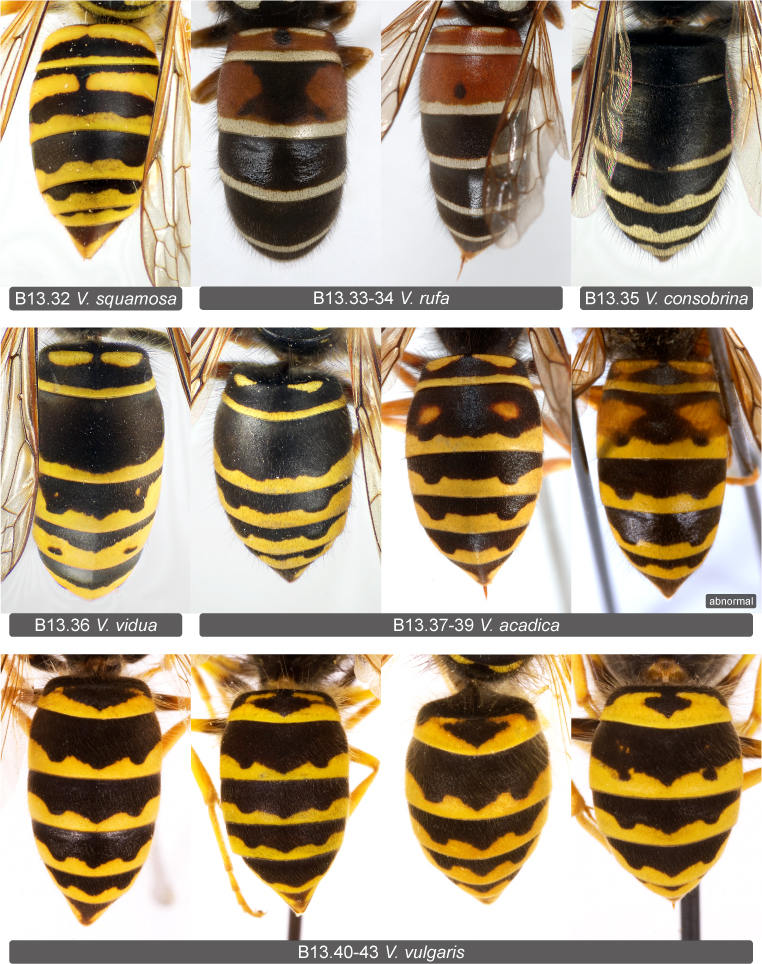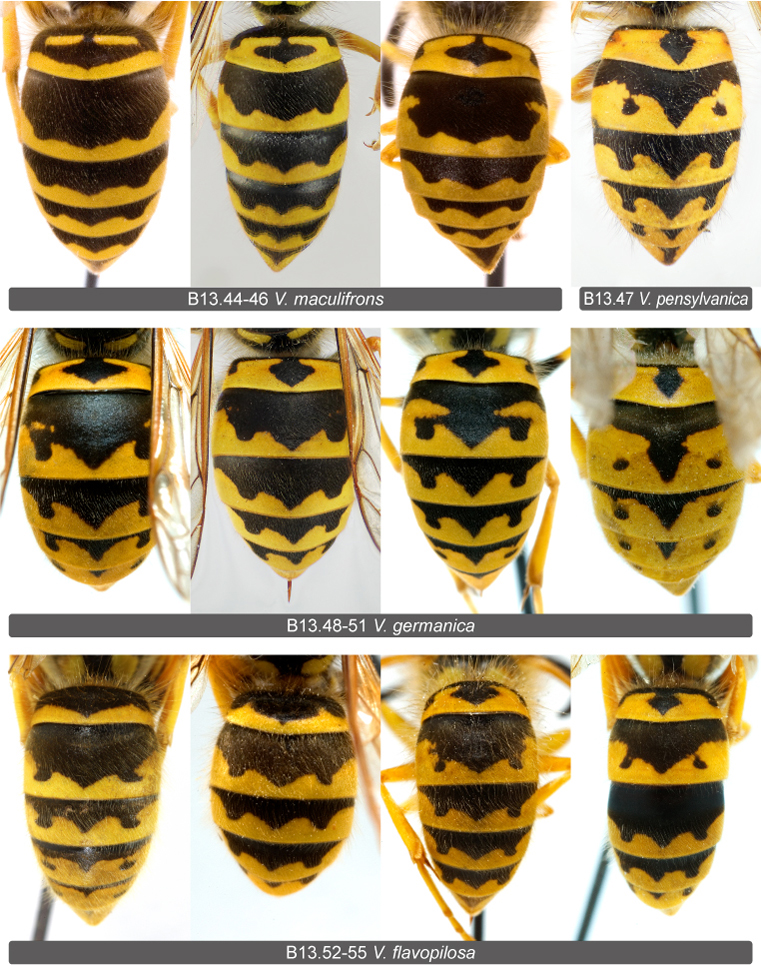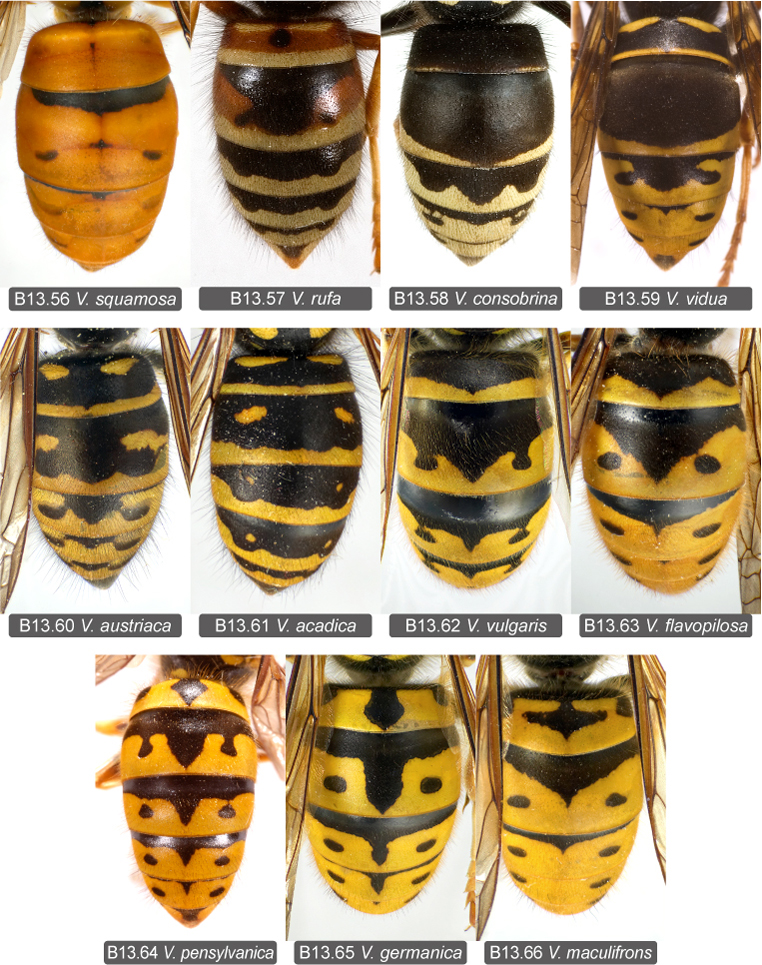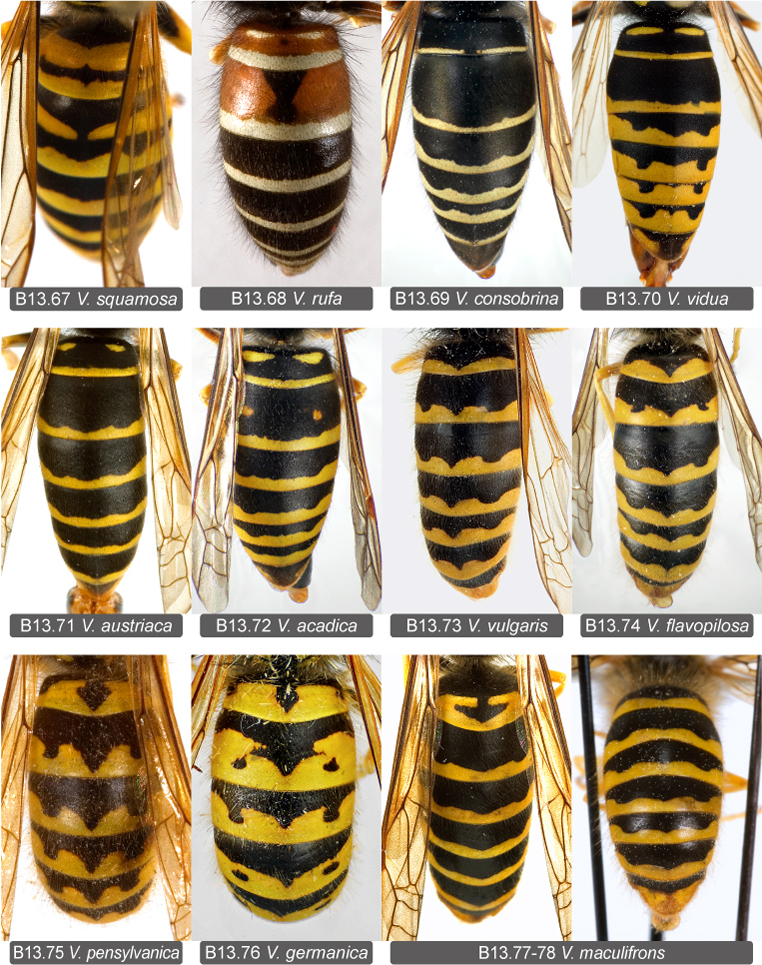
| Home | Table of contents | Keys | Species list | Glossary | Image data | PDF | Cite this article | Feedback | Updates |
Identification Atlas of the Vespidae (Hymenoptera, Aculeata) of the northeastern Nearctic region
CJAI 05, February 19, 2008
doi: 10.3752/cjai.2008.05
Matthias Buck, Stephen A. Marshall, and David K.B. Cheung
Department of Environmental Biology, University of Guelph, Guelph, Ontario, Canada N1G 2W1
Vespula Thomson
This primarily Holarctic and Oriental genus is comprised of 26 species (Carpenter and Kojima 1997, Eck 1998; Dong et al. 2002, 2004; Dong et al. 2005), 13 of which occur in North America (11 in the northeast). Three synanthropic species have been introduced to temperate parts of the southern hemisphere and Hawaii (Carpenter and Kojima 1997) where they are now serious pests.
References. – Eck, 1996 (key to Nearctic species of V. vulgaris-group); Archer, 1989 (key to World species); Akre et al., 1981 (key to Nearctic workers); Jacobson et al., 1978 (key to Nearctic species of V. vulgaris-group); Miller, 1961 (key to Nearctic species excluding V. germanica and V. flavopilosa).
13. Key to eastern Nearctic Vespula species
Notes. Species groups according to Carpenter (1987). Extralimital taxon in brackets.
| 1. | Body with pale markings ivory | V. rufa-group, in part 2 |
| - | Body with pale markings yellow | 3 |
| 2. | Black markings more or less extensively replaced with ferruginous on terga 1 and 2 (Figs 13.33–34, 13.57, 13.68; ferruginous areas sometimes small in queens); tergum 1 with a pair of enclosed ivory basal spots and a broad, uninterrupted, apical fascia. Mostly in subarctic and high boreal zones, extremely rare further south | V. rufa (L.) |
| - | Black markings not replaced with ferruginous; tergum 1 without pale basal spots, its pale apical fascia narrow and interrupted medially, or absent (Figs 13.35, 13.58, 13.69) | V. consobrina (de Saussure) |
| 3. | Scutum with a pair of paramedian longitudinal yellow stripes extending along almost its whole length (Fig. 13.1). Metasomal pattern distinctive: queens with extremely reduced black markings (Fig. 13.56); tergum 2 of workers and males with an additional, discal yellow fascia (interrupted medially) in addition to apical fascia (Figs 13.32, 13.67) (ON: adventitious; eastern U.S.) | V. squamosa (Drury)* |
| * V. squamosa-group | ||
| - | Scutum black, sometimes with a pair of small yellow spots in posterior half (Fig. C91.4). Metasoma always with well developed black pattern, tergum 2 lacking additional discal fascia | 4 |
| 4. | Female (queens and workers): occipital carina absent ventrally; black band between corona and ocular sinus broad (at least 2x mid ocellar diameter), parallel-sided or widening dorsally (Figs 13.3, 13.8–9); black base of tergum 1 with a pair of well defined yellow spots broadly removed from apical fascia (Figs 13.36–38). Male: dorsal surface of tergum 7 straight in profile, not depressed apically (Fig. 13.4); flagellum moderately long, flagellomere II 1.4–1.5x as long as broad | V. rufa-group, in part 5 |
| - | Female: occipital carina continuous to base of mandible (Fig. 13.2); black band between corona and ocular sinus usually narrow dorsally (Figs 13.12, 13.14; width at most one mid ocellar diameter) or interrupted, if broad (V. vulgaris, Fig. 13.13) then black mark of tergum 1 not (or barely) enclosing yellow spots (Figs 13.40–43, 13 62). Male: tergum 7 with apical depression behind median slope, step or overhang (Figs 13.27–29); flagellum very long, flagellomere II 1.9–2.1x as long as broad | V. vulgaris-group, in part 7 |
| 5. | Metasomal terga beyond tergum 1 very sparsely haired and hairs short, often virtually bare (Fig. 13.6). Worker: black discal spot(s) of clypeus small, not connected to subantennal spot (Fig. 13.3). Queen: yellow apical fascia of tergum 2 narrow, evenly concave anteriorly; terga 4 and 5 with free black lateral spots; the spots at most medially close to black basal mark (Fig. 13.59). Male: clypeal disc entirely yellow or with three small black spots | V. vidua (de Saussure) |
| - | Metasomal terga conspicuously haired, the hairs longer and more numerous (Fig. 13.7). Worker: black clypeal spot large, connected to subantennal spot (Fig. 13.9). Queen: either yellow apical fascia of tergum 2 very wide laterally and abruptly narrowed medially (Fig. 13.60), or terga 4 and 5 lacking free black lateral spots (Fig. 13.61; rarely with free lateral spots only narrowly separated from black basal mark on both sides: Fig. C88.2). Male: clypeal disc with one elongate irregular spot usually extending to dorsal and/or ventral margin of clypeus | 6 |
| 6. | Hind tibia with long erect black hairs on at least upper half of outer surface (Fig. 13.5). Queen: tergum 2 with yellow apical fascia very wide laterally, abruptly narrowed medially; terga 3–5 with free or almost free black lateral spots (Fig. 13.60); clypeal apex with teeth strongly produced and slightly curved outward (Fig. 13.8). Male: digitus with long, black, anteriorly directed lobe ventrally (Fig. 13.10). No worker caste (social parasite); female fore wing length 12–13 mm | V. austriaca (Panzer) |
| - | Hind tibia usually without long erect black hairs, rarely with a few hairs dorsally near base. Queen: tergum 2 with yellow apical fascia narrow throughout; terga 2–5 usually with more or less enclosed yellow spots in black area (Fig. 13.61); clypeal apex with teeth less produced (Fig. 13.9). Male: digitus with short, brown, anteriorly directed lobe ventrally (Fig. 13.11); Worker caste present; female fore wing length usually 8.5–10 mm | V. acadica (Sladen) |
| 7. | Female (queens and workers; six metasomal segments) |
8 |
| - | Male (seven metasomal segments) | 12 |
| 8. | Eye margined with yellow dorsally (Fig. 13.12), yellow eye loop rarely narrowly interrupted (ON: adventitious; western Nearctic) | [V. pensylvanica (de Saussure)] |
| - | Eye margined with black dorsally; yellow eye loop absent (e.g., Figs 13.13–14) | 9 |
| 9. | Black band between corona and ocular sinus broad (at least 2x mid ocellar diameter), its outer margin convex to almost straight (Fig. 13.13). Yellow postocular band either interrupted (Fig. 13.15), distinctly narrowed near middle or enclosing black spot. Propodeum entirely black* | V. vulgaris (L.) |
| * Note. According to Eck (1996) all three characters mentioned here may be absent in extreme xanthic forms of V. vulgaris. Such specimens appear to occur mostly in the western part of its range and not in the area covered by this key (nevertheless, Eck mentions one aberrant series from Erie, PA). All specimens examined by us key properly through this couplet. | ||
| - | Black band between corona and ocular sinus narrow (at most 1.5x mid ocellar diameter, exceptionally up to 2x mid ocellar diameter), sometimes interrupted, its outer margin almost always concave or indented (Fig. 13.14). Yellow postocular band complete, neither distinctly narrowed nor with black spot near middle (Fig. 13.16). Worker: propodeum with yellow lateral spots (e.g., Figs 13.16, 13.19) except in some V. maculifrons | 10 |
| 10. | Tergum 1 with anchor-shaped black medial mark or sometimes with black basal mark enclosing a pair of transverse yellow spots (Figs 13.44–46, 13.66); the anchor-shaped mark at least twice as wide as long, very narrow at base (width ca. one mid ocellar diameter, rarely up to 2x mid ocellar diameter) | V. maculifrons (du Buysson) |
| - | Tergum 1 with either diamond-shaped, arrow-shaped, or pentagonal black basal mark (Figs 13.47, 13.48–51, 13.54–55, 13.64–65) or with zigzagged basal area (Figs 13.52–53, 13.63); black basal mark less than twice as wide as long and/or wider at base (width over 3x mid ocellar diameter) | 11 |
| 11. | Worker: tergum 1 with black medial mark diamond-shaped to arrow-shaped (Figs 13.48–51), always narrowed at base with basal width less than 3x mid ocellar diameter; pronotal lobes, scutum, upper mesopleuron behind scrobal furrow and lower mesopleuron never marked with yellow (as in Fig. 13.16). Queen: tergum 1 with yellow apical fascia broadly attaining summit (Fig. 13.65). Worker and queen: third mandibular tooth* with margin distinctly concave (Fig. 13.17) | V. germanica (Fabricius) |
| - | Worker: tergum 1 with black medial mark arrow-shaped to broadly pentagonal, rarely merely zigzagged (Figs 13.52–55), its base varying from not narrowed at all to strongly narrowed; if base of black mark narrowed then yellow spots present on one or more of the following (Fig. 13.19): pronotal lobes, scutum, upper mesopleuron behind scrobal furrow or lower mesopleuron. Queen: tergum 1 with yellow apical fascia not attaining summit (Fig. 13.63). Worker and queen: third mandibular tooth with margin nearly straight* (Fig. 13.18) | V. flavopilosa Jacobson |
| * Note. The difference between the two states is subtle and may prove difficult for the inexperienced user. In worn specimens the original shape of the mandible is difficult to assess. | ||
| 12 | Aedeagus with apical portion inflated and strongly convex ventrally (posterior view), its apical margin with distinct dorsomedial emargination (Fig. 13.20). Tergum 1 with diamond-shaped black mark slightly constricted at base (Figs 13.75–76) | 13 |
| - | Aedeagus with apical portion simple, more or less flat ventrally, its dorsoapical margin not emarginate (Fig. 13.21). Tergum 1 without diamond-shaped black mark, sometimes with pentagonal mark (not constricted at base) or with anchor-shaped mark strongly constricted at base (Figs 13.73–74, 13.77–78) | 14 |
| 13. | Eye margined with black dorsally, never with yellow spot near eye margin (Fig. 13.22). Black subantennal mark lacking deep dorsal emarginations or pair of yellow spots (rarely with single median spot, Fig. 13.22). Tergum 7 with sparse short, semi-erect pubescence below apical margin (Fig. 13.20). Aedeagus with small expansion just basal to apical inflated part (Fig. 13.24) | V. germanica (Fabricius) |
| - | Eye usually margined with yellow dorsally (similar to Fig. 13.12); yellow eye loop present but usually more or less broadly interrupted; eye sometimes margined with black dorsally, but then often with small yellow spot near eye margin. Black subantennal mark almost always with deep dorsal emarginations (sometimes coalescent ventrally) or pair of yellow spots (Fig. 13.23). Tergum 7 with dense, relatively long, semi-erect pubescence below apical margin (Fig. 13.26). Aedeagus slender basal to apical inflated portion (Fig. 13.25) (western Nearctic, adventitious ON) | [V. pensylvanica (de Saussure)] |
| 14. | Tergum 7 with an abrupt, step-like apical depression (Figs 13.28–29, showing extremes); apical emargination of sternum 7 with bevelled margin and small median projection (Fig. 13.30). Tergum 1 usually either with an anchor-shaped black mark (Fig. 13.77) or black basal area with more or less enclosed yellow spots (similar to Fig. 13.44), rarely with plain black basal area (Fig. 13.78) | V. maculifrons (du Buysson) |
| - | Tergum 7 gradually sloping towards apical depression (Fig. 13.27); apical emargination of sternum 7 at most minutely bevelled and lacking medial projection (Fig. 13.31). Tergum 1 neither with anchor-shaped black basal mark nor with black basal area enclosing yellow spots (Figs 13.73–74) | 15 |
| 15. | Black band between corona and ocular sinus broad (at least 2x mid ocellar diameter), its outer margin convex to almost straight (as in Fig. 13.13) | V. vulgaris (L.) |
| - | Black band between corona and ocular sinus narrow (at most one mid ocellar diameter), its outer margin concave or indented (as in Fig. 13.14) | V. flavopilosa Jacobson |
Metasoma of Vespula workers (V. squamosa and V. rufa-group)
Note: the socially parasitic V. austriaca has no worker caste.

Metasoma of Vespula workers (V. vulgaris-group)

Metasoma of Vespula queens (females)

Metasoma of Vespula males

| Home | Table of contents | Keys | Species list | Glossary | Image data | PDF | Cite this article | Feedback | Updates |
